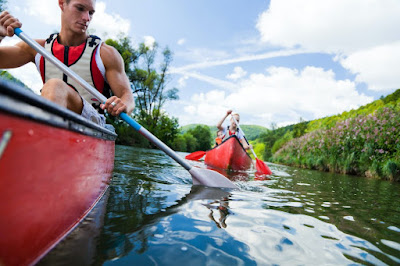One of the hottest adventures you can have is loading up a canoe after camping and set off for your next campsite by paddling out in the lake! This unique activity is called canoe camping. There are many reasons to give this kind of expedition a try, and if you’re already planning on it, make sure you bring all the essential items with you.
We share with you the basics of canoe camping as well as a checklist of the essential gear you should bring.
What is Canoe Camping?
Canoe camping is every water lover’s way of backpacking. Basically, it is a combination of canoeing and camping and is also known as touring, tripping or expedition canoeing. Like backpacking, canoe camping requires carrying of items to their travel and camp.
Self-sufficiency, challenge, and exploration all come together to bring paddlers to beautiful campsites on lakes and rivers throughout the country. Their boat is where canoeists pack everything they need for their trip. Then, they paddle and fish by day, and camp under the stars at night.
Know Your Canoe Skill Level
Not everyone is made for the extreme adventures of canoe camping. Although the guide usually takes care of all logistics like the necessary camping gear, canoes, meals, transportation to and from the river, the route, and the schedule, not all trips are guided and the beginner may feel overwhelmed about these things. That said, good camping and canoeing skills, knowledge of your intended trip, and good judgment are important.
Canoe Camping Gear Checklist
One thing you need to be concerned about when canoe camping is what to bring. Here is a checklist of essential canoe camping gear.
Clothing
There’s nothing worse than being unprepared for the weather when you’re trying to enjoy a day in the great outdoors. You need to wear water-resistant clothes while canoeing to avoid hypothermia and other weather-related issues.
- Paddling gloves or pogies. A long day of paddling can give you blisters.Go for gloves that provide protection against the sun and have contoured layers in high wear areas of your hand.
- Neoprene footwear
- Sandals
- Sry suit or top
- Hat
- Skullcap
- Bandana
- Moisture-wicking t-shirt
- Rashguard
- Swimsuit
- Shorts or convertible pants
- Spray jacket or rainwear
- Gloves or mittens
Canoe Basics
- Canoe. You can’t canoe without a canoe! Factors to consider when choosing a canoe include the purpose, size, hull shape, side shape, freeboard, entry line, materials, number of seats, thwarts, and more.
- Paddle. Arguably the most important thing to bring on a canoe trip other than the canoe itself is the paddle. Paddles also have to be carefully chosen. Consider their length, materials, blade choice, and shaft.
- Dry bags. Even if you don’t flip, your paddles are likely to splash a bit of water into the canoe. Put all of your stuff in a dry bag, and you won’t have to worry about dropping anything in water or water getting into the bag.
- Extra paddle
- Personal floatation device
- Seat
- Knee pads
- Yoke with pads
- Spray covers
- Radio
- Float bags
- Emergency floating throw line
- Bailer or bilge pump
- Sponges
Camping Basics
- Tent. The most important features to look for in a camping tent include the size, the type of poles, the materials including the rainfly and mesh, the zippers, and the type of stitching.
- Sleeping bag
- Sleeping pad
- Meals
- Cooler with ice
- Stove and fuel
- Cookset and utensils
- Dishes and cups
- Insect repellent
- Toilet paper
- Hand sanitizer
- Feminine products
- Camera
- Binoculars
- Packable lantern
Others
- Whistle. A signaling device like a whistle is important in case of an emergency. Whistles are great for taking out on the water with you because they can blow wet or dry, and usually include a neck lanyard.
- Compass
- Maps
- GPS
- Matches
- Knife
- Two-way radios
- Cellphones
- Watch
- Flashlight
- First-aid kit
- Sunglasses
- Sunscreen
- Water treatment method and water bottle
- Energy food
- Beverages or powdered drinks
Learn More:

No comments:
Post a Comment